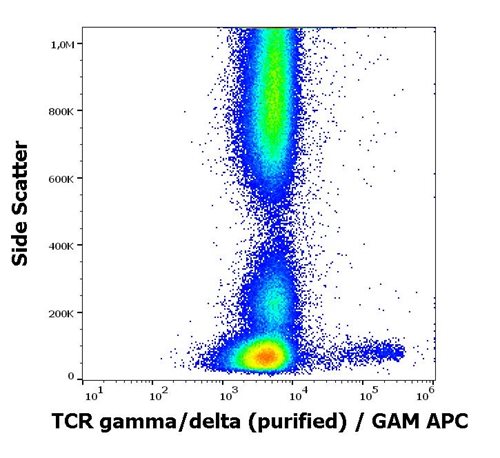Recombinant Human Galectin-8/LGALS8 (E. coli)
Shipping Info:
For estimated delivery dates, please contact us at [email protected]
| Amount : | 50 µg |
| Content : | Lyophilized from a 0.2 µm filtered solution of 20mM PB, 250mM NaCl, pH 7.2. |
| Storage condition : | Lyophilized protein should be stored at -20°C, though stable at room temperature for 3 weeks. Reconstituted protein solution can be stored at 4-7°C for 2-7 days. Aliquots of reconstituted samples are stable at -20°C for 3 months. |
| AA sequence : | MMLSLNNLQNIIYNPVIPFVGTIPDQLDPGTLIVIRGHVPSDADRFQVDLQNGSSMKPRADVAFHFNPRFKRAGCIVCNTLINEKWGREEITYDTPFKREKSFEIVIMVLKDKFQVAVNGKHTLLYGHRIGPEKIDTLGIYGKVNIHSIGFSFSSDLQSTQASSLELTEISRENVPKSGTPQLRLPFAARLNTPMGPGRTVVVKGEVNANAKSFNVDLLAGKSKDIALHLNPRLNIKAFVRNSFLQESWGEEERNITSFPFSPGMYFEMIIYCDVREFKVAVNGVHSLEYKHRFKELSSIDTLEINGDIHLLEVRSW |
Source: E.coli.
MW :35.8kD.
Recombinant Human Galectin-8 is produced by our E.coli expression system and the target gene encoding Met1-Trp317 is expressed. The Galectin family of proteins, with specificity for Nacetyllactosaminecontaining glycoproteins, consists of beta-galactoside binding lectins containing homologous carbohydrate recognition domains (CRDs). At least 14 mammalian galectins family members, which share structural similarities in their carbohydrate recognition domains (CRD), have been identified to date. Unlike the selectin family of proteins, the carbohydrate binding specificity of galectins is calcium-independent. A common function of galectins is to cross-link structures containing N-acetyl-lactosamine located at the cell surface and within the extracellular matrix. They also possess hemagglutination activity, which is attributable to their bivalent carbohydrate binding properties. Galectins are active both intracellularly and extracellularly. Although they are localized primarily in the cytoplasm and lack a classical signal peptide, galectins can also be secreted by one or more unidentified, non-classical, secretory pathways. They have diverse effects on many cellular functions including adhesion, migration, polarity, chemotaxis, proliferation, apoptosis, and differentiation. Galectins may therefore play a key role in many pathological states, including autoimmune diseases, allergic reactions, inflammation, tumor cell metastasis, atherosclerosis, and diabetic complications. The galectins have been classified into the prototype galectins(1, 2, 5, 7, 10, 11, 13, 14), which contain one CRD and exist either as a monomer or a noncovalent homodimer. The chimera galectins(Galectin3) containing one CRD linked to a nonlectin domain, and the tandemrepeat Galectins(4, 6, 8, 9, 12) consisting of two CRDs joined by a linker peptide.Galectins lack a classical signal peptide and can be localized to the cytosolic compartments where they have intracellular functions. However, via one or more as yet unidentified nonclassical secretory pathways, galectins can also be secreted to function extracellularly. Individual members of the galectin family have different tissue distribution profiles and exhibit subtle differences in their carbohydrate-binding specificities. Each family member may preferentially bind to a unique subset of cell surface glycoproteins.
MW :35.8kD.
Recombinant Human Galectin-8 is produced by our E.coli expression system and the target gene encoding Met1-Trp317 is expressed. The Galectin family of proteins, with specificity for Nacetyllactosaminecontaining glycoproteins, consists of beta-galactoside binding lectins containing homologous carbohydrate recognition domains (CRDs). At least 14 mammalian galectins family members, which share structural similarities in their carbohydrate recognition domains (CRD), have been identified to date. Unlike the selectin family of proteins, the carbohydrate binding specificity of galectins is calcium-independent. A common function of galectins is to cross-link structures containing N-acetyl-lactosamine located at the cell surface and within the extracellular matrix. They also possess hemagglutination activity, which is attributable to their bivalent carbohydrate binding properties. Galectins are active both intracellularly and extracellularly. Although they are localized primarily in the cytoplasm and lack a classical signal peptide, galectins can also be secreted by one or more unidentified, non-classical, secretory pathways. They have diverse effects on many cellular functions including adhesion, migration, polarity, chemotaxis, proliferation, apoptosis, and differentiation. Galectins may therefore play a key role in many pathological states, including autoimmune diseases, allergic reactions, inflammation, tumor cell metastasis, atherosclerosis, and diabetic complications. The galectins have been classified into the prototype galectins(1, 2, 5, 7, 10, 11, 13, 14), which contain one CRD and exist either as a monomer or a noncovalent homodimer. The chimera galectins(Galectin3) containing one CRD linked to a nonlectin domain, and the tandemrepeat Galectins(4, 6, 8, 9, 12) consisting of two CRDs joined by a linker peptide.Galectins lack a classical signal peptide and can be localized to the cytosolic compartments where they have intracellular functions. However, via one or more as yet unidentified nonclassical secretory pathways, galectins can also be secreted to function extracellularly. Individual members of the galectin family have different tissue distribution profiles and exhibit subtle differences in their carbohydrate-binding specificities. Each family member may preferentially bind to a unique subset of cell surface glycoproteins.
Always centrifuge tubes before opening. Do not mix by vortex or pipetting. It is not recommended to reconstitute to a concentration less than 100 µg/ml. Dissolve the lyophilized protein in ddH2O. Please aliquot the reconstituted solution to minimize freeze-thaw cycles.
Endotoxin : Less than 0.1 ng/µg (1 IEU/µg) as determined by LAL test.
For Research Use Only. Not for use in diagnostic/therapeutics procedures.
| Subcellular location: | Cytoplasmic vesicle, Cytoplasm |
| Tissue Specificity: | Ubiquitous. Selective expression by prostate carcinomas versus normal prostate and benign prostatic hypertrophy. |
| BioGrid: | 110155. 114 interactions. |
|
There are currently no product reviews
|





















.png)








